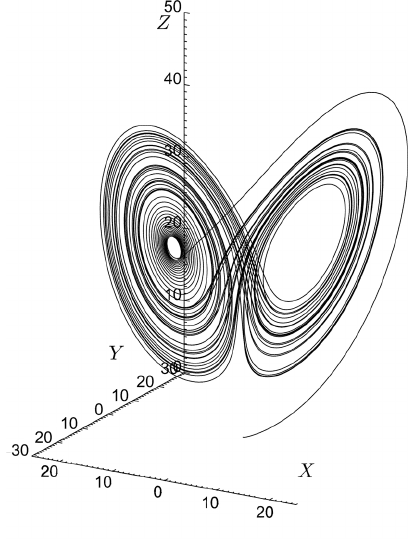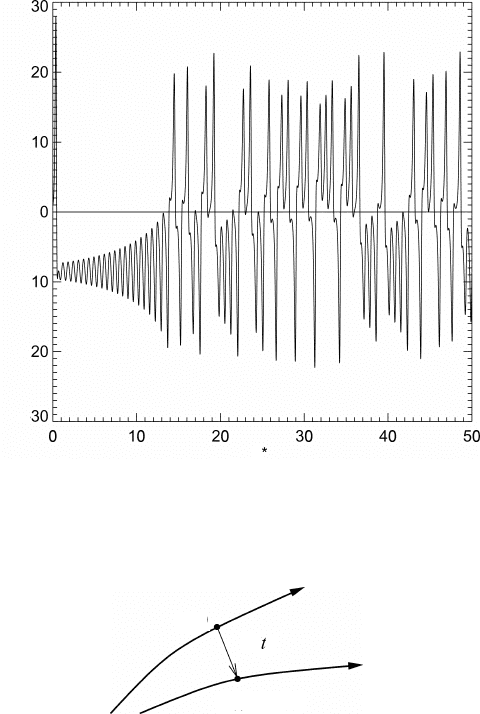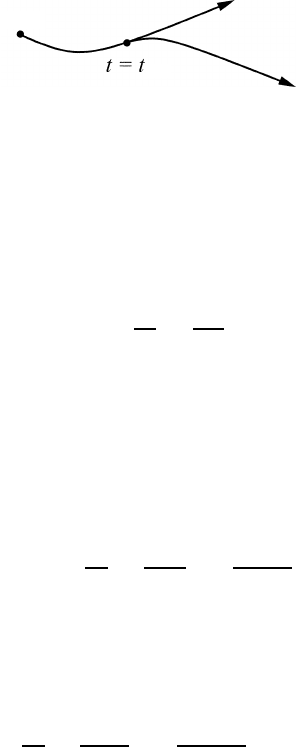Zdunkowski W., Bott A. Dynamics of the atmosphere: A course in theoretical meteorology
Подождите немного. Документ загружается.


27.2 The effect of uncertainties in the initial conditions 681
−
−
−
−
−
Fig. 27.2 Aperiodic motion of the Lorenz system, showing trajectories in the (X,Y,Z)-
space.
may think of this small initial difference as simulating measurement errors, which
can never be avoided entirely. For nonchaotic systems this uncertainty in the initial
conditions leads to a prediction error that grows linearly with time. For chaotic
systems this error grows exponentially with time, so that, after a short time, the
state of the system is essentially unknown. This means that long-term prediction is
impossible for Lorenz-type systems.
27.2 The effect of uncertainties in the initial conditions
We wish to discuss the situation more quantitatively. Let the uncertainties in the
initial conditions be represented by two points on two neighboring trajectories.
Suppose that the transient has decayed so that the trajectory is already on the
attractor. Let X(t) represent a point on the attractor at time t. We consider a nearby
point X(t) +δ(t) on a neighboring trajectory, where δ(t) is a tiny separation vector
of initial length
|
δ
0
|
; see Figure 27.4. Numerical studies of the Lorenz attractor
show that the separation vector changes approximately according to
δ(t) =
|
δ
0
|
exp(λ
L
t),λ
L
≈ 0.9(27.46)

682 Predictability
Y
t
−
−
−
Fig. 27.3 Aperiodic motion of the Lorenz system, showing the Y -component versus
dimensionless time t
∗
.
X(t)
( )
δ
X(t) + δ(t)
Fig. 27.4 Two points in phase space on neighboring trajectories.
where λ
L
is the Liapunov exponent. Hence neighboring trajectories separate ex-
ponentially fast. Actually there are n different Liapunov exponents for an n-
dimensional system but λ
L
≈ 0.9 turns out to be the largest value. Whenever
a system has a positive Liapunov exponent, there is a time horizon beyond which
prediction breaks down. This is shown schematically in Figure 27.5. Beyond t = t
hor
the predictability breaks down. The two initial conditions represented by points on
the plot are so closely spaced that they cannot be distinguished.
Let us assume that the initial conditions of some physical experiment have been
determined very accurately. Nevertheless, a small measurement error will always
occur so that the measured initial condition differs from the true initial condition by
|
δ
0
|
.Aftertimet of the prediction period the discrepancy has increased according

27.3 Limitations of deterministic predictability of the atmosphere 683
t = 0
hor
Fig. 27.5 A schematic plot of the time horizon where the two trajectories diverge rapidly.
to (27.46). We must permit a certain acceptable tolerance in the accuracy of the
prediction. Let a be a measure of this tolerance, i.e. if a prediction is within a of the
true state, then the prediction is tolerable. Thus the prediction becomes intolerable
if
|
δ(t)
|
≥ a. According to (27.46) the order of magnitude O of the time interval
t
hor
may be expressed as
t
hor
≈ O
1
λ
L
ln
a
|
δ
0
|
(27.47)
Let us consider the following idealized example, which has little to do with
actual weather prediction. In a first attempt, we are trying to predict a chaotic
system within a tolerance of a = 10
−3
, assuming that the initial state is uncertain
to within
|
δ
0
|
= 10
−7
. For what time period can we predict the state of the system
and still remain within the given tolerance? In this case the time horizon is given
by
t
hor
(1) ≈
1
λ
L
ln
10
−3
10
−7
=
4ln10
λ
L
(27.48)
In a second attempt we succeed in measuring the initial state a million times better
so that
|
δ
0
|
= 10
−13
. How much longer can we predict within the tolerance limits?
The result is disappointing, as follows from
t
hor
(2) ≈
1
λ
L
ln
10
−3
10
−13
=
10 ln 10
λ
L
= 2.5t
hor
(1) (27.49)
The conclusion is that a million-fold improvement in the initial uncertainty permits
us to predict for only 2.5 times longer. Lorenz suggested that this logarithmic
dependency on
|
δ
0
|
is what makes long-term weather prediction so difficult.
27.3 Limitations of deterministic predictability of the atmosphere
In the previous section we gave a rather artificial example of the Liapunov time
horizon of a chaotic system that is difficult to apply to weather prediction. It is at
present not possible to state this time horizon in a general form since the time span
of predictability depends on the scale of the fields to be predicted and also on the
synoptic situation.

684 Predictability
Table 27.1. Spatial and time scales of atmospheric motion
Motion Spatial scale Time scale
Turbulence 0.1–100 m 1–1000 s
Convection 0.1–10 km 1–60 min
Mesoscale motion 1–1000 km 30 min to several days
Large-scale motion 1000–10 000 km 1–10 days
After and even before Lorenz (1963) published his celebrated paper, a number of
publications attempting to assess the predictability of the atmosphere appeared in
the literature. To a large extent, the prediction of the future state of the atmosphere
for an extended time period is very difficult due to the width of the spectrum of
atmospheric processes. To give an impression of the scales of motion, we present in
Table 27.1 a very rough classification of the spatial and time scales of atmospheric
motion.
More refined classifications are avaliable, see e.g. Orlanski (1975). For large-
scale motion the characteristic scales are determined by the wavelength and the
period of the planetary waves. On smaller scales the dimensions and life times
of turbulent vortices determine the characteristic scales. Nonlinear interactions of
physical processes between different scales take place continually and vary strongly
in time and space.
Weather prediction on a mathematical–physical basis proceeds as follows. In
order to study weather phenomena of a certain scale, we must construct a math-
ematical model by employing the methods of scale analysis. The model is made
deterministic by parameterizing the interactions with neighboring scales in terms
of available model variables. Since a general parameterization theory is not yet
available, it is necessary to employ empirical knowledge to determine the pa-
rameter functions. This procedure introduces nondeterministic elements into the
prediction model. In order to develop a global circulation model, for example, it
would be necessary to parameterize the interactions with the complete spectrum
of the subsynoptic processes. So far this problem has not been solved satisfacto-
rily.
In order to carry out short- and medium-range numerical weather forecasts, it
is necessary to initialize the model with consistent input data in order to integrate
the predictive system of differential equations forward in time. The field of the
initial data may be obtained with the help of an objective analyis. Procedures for
how to carry out this analysis are given by Haltiner and Williams (1980) and in
more recent references. Various sophisticated methods have been devised in or-
der to make the observed data physically and computationally as consistent with
27.3 Limitations of deterministic predictability of the atmosphere 685
the numerical model as possible. Methods have been proposed for producing an
objective analysis by statistically extracting the maximum amount of information
from observations, climatological data, spatial correlations between meteorological
variables, and other available data. This type of procedure, known as the optimum
interpolation, requires knowledge of the statistical structure of the fields of meteo-
rological variables. Nevertheless, upon completion of the objective analysis, mass
and motion fields are still not precisely balanced.
Naturally, questions about the sensitivity of the weather-prediction model arise
due to uncertainties in the parameterized interaction with neighboring scales, the
uncertainties in the initial conditions, and the particular properties of the numerical
scheme. In other words, for what prediction time interval is the deterministic
character of the model equations prevalent before the nondeterministic elements
begin to dominate the prediction? We can well imagine that there must be limitations
to deterministic predictability, which vary from one mathematical model to the next.
In the remaining part of this chapter we will investigate the uncertainties in the
initial conditions.
Among various attempts to investigate the predictability of the atmosphere,
Lorenz (1969) modeled the atmosphere with the help of the divergence-free
barotropic vorticity equation in which the horizontal velocity is expressed in terms
of the stream function. Assuming “exact” initial conditions and ignoring possible
errors due to the numerical procedure, the solution of this deterministic equation
should result in an “exact” deterministic prediction over an arbitrarily long period
of time. Exact initial conditions, however, do not exist, so the predicted fields
are expected to be at variance with nature after a certain time span. Moreover,
it should be realized that the model equations are too simple to approximate the
actual atmospheric behavior over an extended time period.
To simulate the effect of uncertainties in the initial conditions, two predictions
may be carried out. The first prediction uses initial conditions that are defined to
be exact. The prediction on the basis of the model equations is deterministic and
“exact,” thus correctly representing the nature of the model. The second prediction
uses somewhat different initial conditions, which simulate imperfect measurements
and other errors. After a longer prediction time the results differ so much that, even
on the largest scales, they are not even similar. In fact, Lorenz showed that, on the
basis of hardly discernible differences in the initial conditions of the subsynoptic
scales, but identical initial conditions in the synoptic scale, after three weeks of
prediction time the two forecasts were so different that they could not be compared
in a reasonable way. We may conclude from this numerical investigation that
the atmosphere has forgotten the initial conditions altogether after a time span
of no more than four weeks. The short memory of the atmosphere is caused by
the nonlinear interactions taking place, which are accompanied by a propagation
686 Predictability
of errors relative to the initial conditions. This memory property has been well
known for many years from the numerical experiments simulating the general
circulation. Even on starting the numerical integration with the simplest and most
unrealistic initial conditions, that is a resting atmosphere and isothermal vertical
temperature stratification, due to an influx of energy and to friction a reasonably
realistic atmosphere has evolved after a time span of only one month. Again,
this implies that the atmosphere has completely forgotten the unrealistic initial
conditions.
Proponents of the so-called stochastic dynamic method of weather prediction and
others have criticized the conclusions resulting from Lorenz’s numerical investi-
gation. They argued that the Lorenz model, ignoring even the important β effect,
is too simple to give a realistic estimate of the limits of atmospheric predictability.
The prediction range can be extended by applying the stochastic dynamic method
to the Lorenz scheme and to more complete prediction models. The stochastic
dynamic approach apparently was initiated by Obuchov (1967). Just like any other
dynamic prediction, the method is based on the deterministic model equations
generally used to describe the atmosphere. The novel part is that this method in-
troduces the concept of uncertainty in the initial conditions by means of statistical
characteristics.
Even if the initial conditions cannot be precisely known, from experience we
have developed some ideas about the most probable forms of the fields of variables
describing the initial state of the atmosphere. The typical operational forecast
requires one field of initial data for each variable with unknown errors. Instead of
prescribing a single set of initial fields of the variables, one prescribes a set of initial
fields of variables by means of a probability distribution of initial fields. Instead of
a single forecast resulting from a single set of initial fields of the variables, a great
number of forecasts can be produced. How one might obtain an approximation of
the initial joint probability distribution will not be discussed here. For our purposes
we simply assume that it can be constructed in some way.
Any probability distribution may be characterized by the usual statistical mea-
sures: expectation, variance, and higher moments. Thus we may describe the joint
probability distribution of the initial fields of variables by these statistical measures.
Moreover, we may also calculate the same statistical measures from the collection
of the predicted fields. For various times and spatial points the statistical measures
of the predicted fields may be related to the corresponding measures of the initial
fields. The prediction of the statistical measures of the variables is the core of
the stochastic dynamic prediction. This forecasting procedure makes it possible to
extend the predictability horizon. By employing the barotropic vorticity equation
in the form used by Lorenz, it is possible to increase the duration of predictability
significantly.
27.3 Limitations of deterministic predictability of the atmosphere 687
In the following we will give a brief mathematical description of the stochastic
dynamic method. Lorenz (1963) had already recognized that all meteorological
prediction equations, after transformation into the spectral domain, can be written
in the form
˙
X
k
=
m
n
A
kmn
X
m
X
n
−
m
B
km
X
m
+ C
k
(27.50)
where the X
k
are general time-dependent variables describing the state of the
atmosphere. The time t is the only independent variable; A, B, C are constants
describing the nonlinear interaction, external forces, and dissipative mechanisms.
The symbols m and n are dummy indices. Fortak (1973) verified the form (27.50)
by employing the following five dependent variables: the three components of the
wind vector (u, v, w), the Exner function 6 = c
p
(p/p
0
)
R
0
/c
p,0
, and the potential
temperature θ. By developing the five scalar variables in the form
u
v
w
=
N
m=1
F
m
u
m
v
m
w
m
,6=
N
m=1
F
m
6
m
,θ=
N
m=1
F
m
θ
m
(27.51)
where F
k
= F
k
(x,y, z) is a suitable normalized three-dimensional orthogonal func-
tion, we obtain a set of five ordinary differential equations ( ˙u
k
, ˙v
k
, ˙w
k
,
˙
6
k
,
˙
θ
k
)
of relatively simple structure.
In order to proceed with our discussion, we do not need to know the mathematical
form of the F
k
and need not repeat Fortak’s analysis. The functions F
k
may be
obtained in generalization to the two-dimensional case, see Abramowitz and Segun
(1968). Suppose, for example, that the spatial fields are resolved to a wavenumber
N = 20. In this case we would have to evaluate deterministically 5N = 100
nonlinear coupled time-dependent ordinary differential equations for the coefficient
functions X
k
assuming the existence of exact initial conditions of the variables.
Imagining that this 5N-dimensional space is spanned by the totality of the variables
X
k
then the state of the system in phase space at a certain time is represented by a
point. As we have previously discussed, any changes in the state of this system are
represented by the motion of this point or by a trajectory in phase space.
We know that the initial conditions cannot be specified exactly. This is equiv-
alent to saying that we do not know the exact location of the point in phase
space specifying the initial state t = t
0
. Suppose that the probability density
P (X
1
,X
2
,...,X
5N
,t
0
) for the position of the point is available with P>0forall

688 Predictability
X
k
and all t. By definition, the normalization condition
∞
−∞
···
P (X
1
,X
2
,...,X
5N
,t) dX
1
dX
2
···dX
5N
=
∞
−∞
···
P (X
1
,X
2
,...,X
5N
,t) dτ = 1
(27.52)
must be valid for all t. The evolution with time of the probability density follows
from the differentiation with respect to time of the normalization condition. By
employing Lagrange’s method we obtain
d
dt
∞
−∞
···
Pdτ
=
∞
−∞
···
dP
dt
dτ +
∞
−∞
···
P
1
dτ
d
dt
(dτ)
dτ = 0
(27.53)
The expression in parentheses on the right-hand side represents the relative change
in volume or the divergence:
1
dτ
d
dt
(dτ) =
5N
m=1
∂
˙
X
m
∂X
m
(27.54)
which is a generalization of the three-dimensional case; see (M6.38b). Next we
replace dP /d t in (27.53) by the generalized Euler expansion
dP
dt
=
∂P
∂t
+
5N
m=1
˙
X
m
∂P
∂X
m
(27.55)
Substitution of this expression together with (27.54) into (27.53) yields
d
dt
∞
−∞
···
Pdτ
=
∞
−∞
···
∂P
∂t
+
5N
m=1
∂
∂X
m
(P
˙
X
m
)
dτ = 0(27.56)
In differential form this equation may be written as
∂P
∂t
+
5N
m=1
∂
∂X
m
(P
˙
X
m
) = 0(27.57)
which is known as the Liouville equation or the continuity equation for the proba-
bility density.
Equation (27.57) can be evaluated, at least in principle, if we replace
˙
X
k
by
(27.50). This results in
∂P
∂t
+
5N
m=1
∂
∂X
m
P
5N
r=1
5N
s=1
A
mrs
X
r
X
s
−
5N
r=1
B
mr
X
r
+ C
m
= 0(27.58)
27.4 Basic equations of the approximate stochastic dynamic method 689
which describes the evolution with time of the probability density for a specific me-
teorological problem as formulated by a model. The latter equation was originally
and independently derived by Epstein (1969) and by Tatarsky (1969). In principle,
this equation can be solved numerically if P (t = t
0
) is known and if the boundary
conditions for P (vanishing at infinity) can be satisfied.
At present the numerical effort required in order to solve (27.58) is prohibitively
expensive and practically impossible. Tatarsky and Epstein pointed out that com-
plete knowledge of P includes much superfluous information. So it is usually
sufficient to know the simplest moments describing essential characteristics of the
distribution instead of knowing the complete distribution. These are the first and the
second moment. The first moment is the expectation or mean value of the variable
while the second moment is related to the covariance. Knowledge of these two
statistical measures is sufficient for approximating the actual probability density
by the Gaussian distribution.
27.4 Basic equations of the approximate stochastic dynamic method
We will now derive the prognostic equations for the expectation value and for
the covariance tensor. These equations were given independently by Tatarsky and
Epstein. It turns out that we will have to deal with the same type of closure problem
as that which is known to us from the theory of turbulence.
The first moment or the expectation value of X, also known as the mean value
µ
k
,isdefinedby
E(X
k
) = µ
k
=
∞
−∞
···
X
k
P (X
1
,X
2
,...,X
5N
,t) dτ (27.59)
The second moment ρ
kl
is given by
ρ
kl
(t) =
∞
−∞
···
X
k
X
l
P (X
1
,X
2
,...,X
5N
,t) dτ (27.60)
This quantity is related to the covariance σ
kl
as will be shown next. In analogy to
the theory of turbulence, we split the variable X
k
into the mean value µ
k
plus the
deviation X
k
X
k
= µ
k
+ X
k
with E(X
k
) = 0(27.61)
By definition, the expectation value of the deviation X
k
is zero. Equation (27.60)
involves the product X
k
X
l
. By introducing (27.61) into this product we find
X
k
X
l
= µ
k
µ
l
+ X
k
µ
l
+ X
l
µ
k
+ X
k
X
l
(27.62)

690 Predictability
On applying the expectation operator to (27.62) we immediately find
E(X
k
X
l
) = µ
k
µ
l
+ σ
kl
with σ
kl
= E(X
k
X
l
)(27.63)
Since E(X
k
X
l
) = ρ
kl
we have found the relation between the second moment
and the covariance. The expectation value of a function is defined analogously to
(27.59) simply by replacing X
k
by the function f (X
1
,X
2
,...,X
5N
).
Of primary importance to stochastic dynamic forecasting is the time derivative
of the expectation value. With the help of the Liouville equation (27.57) it is not
very difficult to prove the validity of
d
dt
[E(f )] = E
df
dt
(27.64)
showing that the mathematical expectation operator and the time derivative may
be interchanged. We will leave the proof to the exercises.
To find the prognostic equation of the mean value µ
k
we first apply the expecta-
tion operator to equation (27.50) and obtain
E
dX
k
dt
=
5N
m=1
5N
n=1
A
kmn
E(X
m
X
n
) −
5N
m=1
B
km
E(X
m
) + C
k
E(1) (27.65)
With the help of (27.63) and (27.64) it is not difficult to obtain the desired equation
˙µ
k
=
5N
m=1
5N
n=1
A
kmn
µ
m
µ
n
−
5N
m=1
B
km
µ
m
+ C
k
+
5N
m=1
5N
n=1
A
kmn
σ
mn
(27.66)
Comparison of (27.66) with (27.50) shows the similarity between these two equa-
tions. The first three terms are identical in form. In place of X
k
in (27.50) we now
have the mean value µ
k
. The decisive difficulty with equation (27.66) arises from
the last term, which requires knowledge of the covariance σ
kl
. Thus we need to
derive a prognostic equation for the covariance. If there were no uncertainties, the
covariance tensor σ
kl
would be zero and the final term would vanish so that there
would be no need to obtain a prognostic equation for σ
kl
. In practical situations this
idealized case of zero uncertainties does not occur. The analogy with averaging
the equation of motion is apparent since the averaging procedure produces the
Reynolds stress tensor as an additional term.
Now we direct our attention to the evaluation of the covariance term in (27.66).
There is no formal difficulty in finding the prognostic equation for σ
kl
. All we need
to do is to differentiate (27.63) with respect to time, yielding
˙σ
kl
= E(
˙
X
k
X
l
) + E(X
k
˙
X
l
) − ˙µ
k
µ
l
− µ
k
˙µ
l
(27.67)
